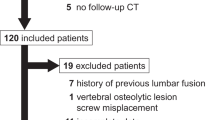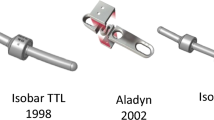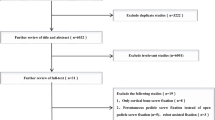Abstract
Objectives
The evaluation of lumbar interbody fusion status is generally subjective and may differ among raters. The authors examined whether the assessment of position change of screw-rod constructs could be an alternative method for the evaluation of fusion status.
Methods
Sixty-three patients undergoing lumbar interbody single-level fusion were retrospectively reviewed. Three-dimensional images of screw-rod constructs were created from baseline CT examination on the day after surgery and follow-up CT examinations (3–5 months, 6–11 months, and ≥ 12 months) and superposed, with position change of screw-rod constructs being evaluated by the distance between the 3-dimensional images at baseline and follow-up. The evaluation was repeated twice to confirm the reproducibility. Fusion status on follow-up CT examinations was assessed by three raters, where inter-rater reliability was evaluated with Fleiss’ kappa. The results of the fusion status were classified into fusion and incomplete fusion groups in each timing of follow-up CT examinations, where the amount of position change was compared between the two groups.
Results
The evaluation of position change was completely reproducible. The Fleiss’ kappa (agreements) was 0.481 (69.4%). The medians of the amount of position change in fusion and incomplete fusion groups were 0.134 mm and 0.158 mm at 3–5 months (p = 0.21), 0.160 mm and 0.190 mm at 6–11 months (p = 0.02), and 0.156 mm and 0.314 mm at ≥ 12 months (p = 0.004).
Conclusions
The assessment of position change of screw-rod constructs at 6 months or more after surgery can be an alternative method for evaluating lumbar interbody fusion status.
Key Points
• Lumbar interbody fusion status (satisfactory, incomplete, or failed) is associated with the quantification of position change of screw-rod in this study.
• Reference values for the evaluation of position change in identifying interbody fusion status are provided.
• Position change of screw-rod could be a supportive method for evaluating interbody fusion status.





Similar content being viewed by others
Abbreviations
- 3D:
-
3-dimensional
- AUC:
-
Area under the receiver operating characteristic curve
- CI:
-
Confidence interval
- HU:
-
Hounsfield unit
- ROC:
-
Receiver operating characteristic
References
Williams AL, Gornet MF, Burkus JK (2005) CT evaluation of lumbar interbody fusion: current concepts. AJNR Am J Neuroradiol 26:2057–2066
Adogwa O, Parker SL, Shau D et al (2011) Long-term outcomes of revision fusion for lumbar pseudarthrosis: clinical article. J Neurosurg Spine 15:393–398
McLain RF, Sparling E, Benson DR (1993) Early failure of short-segment pedicle instrumentation for thoracolumbar fractures. A preliminary report. J Bone Joint Surg Am 75:162–167
Berjano P, Bassani R, Casero G, Sinigaglia A, Cecchinato R, Lamartina C (2013) Failures and revisions in surgery for sagittal imbalance: analysis of factors influencing failure. Eur Spine J 22(Suppl 6):S853–S858
Tanioka S, Fujimoto M, Nishikawa H et al (2021) A screw position change at an early postoperative stage preceding the subsequent occurrence of screw loosening. Eur Spine J 30:136–141
Tanioka S, Fujimoto M, Nishikawa H et al (2022) Radiolucent zone around screws is associated with position change of screw-rod constructs. Clin Neuroradiol 32:717–724
Tanioka S, Ishida F, Kuraishi K et al (2019) A novel radiological assessment of screw loosening focusing on spatial position change of screws using an iterative closest point algorithm with stereolithography data: technical note. World Neurosurg 124:171–177
Lee N, Kim KN, Yi S et al (2017) Comparison of outcomes of anterior, posterior, and transforaminal lumbar interbody fusion surgery at a single lumbar level with degenerative spinal disease. World Neurosurg 101:216–226
Cunningham BW, Kanayama M, Parker LM et al (1999) Osteogenic protein versus autologous interbody arthrodesis in the sheep thoracic spine. A comparative endoscopic study using the Bagby and Kuslich interbody fusion device. Spine (Phila Pa 1976) 24:509–518
Willems K, Lauweryns P, Verleye G, Goethem JV (2019) Randomized controlled trial of posterior lumbar interbody fusion with ti- and cap-nanocoated polyetheretherketone cages: comparative study of the 1-year radiological and clinical outcome. Int J Spine Surg 13:575–587
Tokuhashi Y, Matsuzaki H, Oda H, Uei H (2008) Clinical course and significance of the clear zone around the pedicle screws in the lumbar degenerative disease. Spine (Phila Pa 1976) 33:903–908
Mora H, Mora-Pascual JM, Garcia-Garcia A, Martinez-Gonzalez P (2016) Computational analysis of distance operators for the iterative closest point algorithm. PLoS One 11:e0164694
Sanden B, Olerud C, Petren-Mallmin M, Johansson C, Larsson S (2004) The significance of radiolucent zones surrounding pedicle screws. Definition of screw loosening in spinal instrumentation. J Bone Joint Surg Br 86:457–461
Kim DH, Hwang RW, Lee GH et al (2020) Comparing rates of early pedicle screw loosening in posterolateral lumbar fusion with and without transforaminal lumbar interbody fusion. Spine J 20:1438–1445
Shah RR, Mohammed S, Saifuddin A, Taylor BA (2003) Comparison of plain radiographs with CT scan to evaluate interbody fusion following the use of titanium interbody cages and transpedicular instrumentation. Eur Spine J 12:378–385
Behrbalk E, Uri O, Parks RM, Musson R, Soh RC, Boszczyk BM (2013) Fusion and subsidence rate of stand alone anterior lumbar interbody fusion using PEEK cage with recombinant human bone morphogenetic protein-2. Eur Spine J 22:2869–2875
Seo DK, Kim MJ, Roh SW, Jeon SR (2017) Morphological analysis of interbody fusion following posterior lumbar interbody fusion with cages using computed tomography. Medicine (Baltimore) 96:e7816
Massaad E, Fatima N, Kiapour A, Hadzipasic M, Shankar GM, Shin JH (2020) Polyetheretherketone versus titanium cages for posterior lumbar interbody fusion: meta-analysis and review of the literature. Neurospine 17:125–135
Funding
The authors state that this work has not received any funding.
Author information
Authors and Affiliations
Corresponding author
Ethics declarations
Guarantor
The guarantor is Satoru Tanioka.
Conflict of interest
The authors of this manuscript declare no relationships with any companies, whose products or services may be related to the subject matter of the article.
Statistics and biometry
One of the authors has significant statistical expertise.
Informed consent
Written informed consent was waived by the institutional review board.
Ethical approval
Institutional review board approval was obtained.
Methodology
• retrospective
• diagnostic study
• performed at one institution
Additional information
Publisher’s note
Springer Nature remains neutral with regard to jurisdictional claims in published maps and institutional affiliations.
Rights and permissions
Springer Nature or its licensor (e.g. a society or other partner) holds exclusive rights to this article under a publishing agreement with the author(s) or other rightsholder(s); author self-archiving of the accepted manuscript version of this article is solely governed by the terms of such publishing agreement and applicable law.
About this article
Cite this article
Yamamoto, A., Tanioka, S., Fujimoto, M. et al. An alternative method to evaluate lumbar interbody fusion status focusing on position change of screw-rod constructs. Eur Radiol 33, 1545–1552 (2023). https://doi.org/10.1007/s00330-022-09194-4
Received:
Revised:
Accepted:
Published:
Issue Date:
DOI: https://doi.org/10.1007/s00330-022-09194-4




